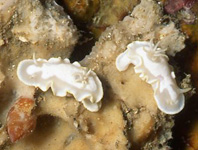Abstract
The use of molecular data for documenting biodiversity has become more common over time as larger datasets can be generated faster. Nevertheless, studies addressing phenotypical data have not become as common. As a collateral effect, many samples used in molecular studies are assigned to a species without checking phenomic characters of the vouchers. Correct specific assignment is paramount for any biological hypothesis. A recent review of Phyzelaphryninae, while producing interesting results, has not specified how some vouchers used in molecular analyses were assigned to each species. Using new sequences from fresh material collected in Southern Bahia, we re-identify Adelophryne specimens based on molecular and morphological grounds. This new taxonomic understanding clarifies the phylogenetic position of A. pachydactyla and highlights a more parsimonious explanation for the evolution of a morphological character—the reduction of a phalange on Finger IV—within Adelophryne.
References
Andrade-Lima, D. (1966) Vegetação. In: IBGE (Ed.), Atlas Nacional do Brasil. Conselho Nacional de Geografia, Rio de Janeiro, pp. 1–122.
Akaike, H. (1974) A new look at the statistical model identification. IEEE transactions on automatic control, 19 (6), 716–723.
https://doi.org/10.1109/TAC.1974.1100705Batalha-Filho, H., Fjeldså J., Fabre, P.-H. & Miyaki, C.Y. (2013) Connections between the Atlantic and the Amazonian forest avifaunas represent distinct historical events. Journal of Ornithology, 154, 41–50.
https://doi.org/10.1007/s10336-012-0866-7Blotto, B.L., Nuñez, J.J., Basso, N.G., Úbeda, C.A., Wheeler, W.C. & Faivovich, J. (2013) Phylogenetic relationships of a Patagonian frog radiation, the Alsodes + Eupsophus clade (Anura: Alsodidae), with comments on the supposed paraphyly of Eupsophus. Cladistics, 29, 113–131.
https://doi.org/10.1111/j.1096-0031.2012.00417.xCaramaschi, U., Orrico, V.G.D., Faivovich, J., Dias, I.R. & Solé, M. (2013) A New Species of Allophryne (Anura: Allophrynidae) from the Atlantic Rain Forest Biome of Eastern Brazil. Herpetologica, 69, 480–491.
https://doi.org/10.1655/HERPETOLOGICA-D-13-00029Darst, C.R. & Cannatella, D.C. (2004) Novel relationships among hyloid frogs inferred from 12S and 16S mitochondrial DNA sequences. Molecular Phylogenetics and Evolution, 31, 462–475.
https://doi.org/10.1016/j.ympev.2003.09.003Fernandes, D.S., Franco, F.L. & Fernandes, R. (2004) Systematic revision of the genus Lachesis Daudin, 1803 (Serpentes, Viperidae). Herpetologica, 60, 245–260.
https://doi.org/10.1655/02-85Fouquet, A., Loebmann, D., Castroviejo-Fisher, S., Padial, J.M., Orrico, V.G.D., Lyra, M.L., Roberto, I.J., Kok, P.J.R., Haddad, C.F.B. & Rodrigues, M.T. (2012) From Amazonia to the Atlantic forest: Molecular phylogeny of Phyzelaphryninae frogs reveals unexpected diversity and a striking biogeographic pattern emphasizing conservation challenges. Molecular Phylogenetics and Evolution, 65, 547–561.
https://doi.org/10.1016/j.ympev.2012.07.012Goloboff, P.A., Catalano, S.A., Marcos Mirande, J., Szumik, C.A., Salvador Arias, J., Källersjö, M. & Farris, J.S. (2009) Phylogenetic analysis of 73 060 taxa corroborates major eukaryotic groups. Cladistics, 25, 211–230.
https://doi.org/10.1111/j.1096-0031.2009.00255.xHall, T.A. (1999) BioEdit: a user-friendly biological sequence alignment editor and analysis. Department of Microbiology, North Carolina State University. Available from: http://brownlab.mbio.ncsu.edu/JWB/papers/1999Hall1.pdf (accessed 26 June 2018)
Hoogmoed, M.S. & Lescure, J. (1984) A new genus and two new species of minute leptodactylid frogs from northern South America, with comments upon Phyzelaphryne (Amphibia: Anura: Leptodactylidae). Zoologische Mededelingen. Leiden, 58, 85–115.
Hoogmoed, M.S., Borges, D.M. & Cascon, P. (1994) Three new species of the genus Adelophryne (Amphibia: Anura: Leptodactylidae) from northeastern Brazil, with remarks on the other species of the genus. Zoologische Mededelingen, Leiden, 68, 271–300.
Kumar, S., Stecher, G. & Tamura, K. (2016) MEGA7: molecular evolutionary genetics analysis version 7.0 for bigger datasets. Molecular biology and evolution, 33, 1870–1874.
https://doi.org/10.1093/molbev/msw054Lanfear, R., Calcott, B., Ho, S.Y.W. & Guindon, S. (2012) PartitionFinder: combined selection of partitioning schemes and substitution models for phylogenetic analyses. Molecular Biology and Evololution, 29, 1695–1701.
https://doi.org/10.1093/molbev/mss020Lourenço-de-Moraes, R., Solé, M. & Toledo, L.F. (2012) A new species of Adelophryne Hoogmoed and Lescure 1984 (Amphibia: Anura: Eleutherodactylidae) from the Atlantic rainforest of southern Bahia, Brazil. Zootaxa, 3441, 59–68.
Lourenço-de-Moraes, R., Ferreira, R.B., Fouquet, A. & Bastos, R.P. (2014) A new diminutive frog species of Adelophryne (Amphibia: Anura: Eleutherodactylidae) from the Atlantic Forest, southeastern Brazil. Zootaxa, 3846 (3), 348–360.
https://doi.org/10.11646/zootaxa.3846.3.2MacCulloch, R.D., Lathrop, A., Kok, P.J.R., Minter, L.R., Khan, S.Z. & Barrio-Amorós, C.L. (2008) A new species of Adelophryne (Anura: Eleutherodactylidae) from Guyana, with additional data on A. gutturosa. Zootaxa, 1884, 36–50.
Nemésio, A. (2012) The western limits of the “Hileia Baiana” for orchid bees, including seven new records for the state of Minas Gerais, eastern Brazil. Spixiana, 35, 109–116.
Orrico, V.G.D., Nunes, I., Mattedi, C., Fouquet, A., Lemos, A.W., Rivera-Correa, M., Lyra, M.L., Loebmann, D., Pimenta, B.V.S., Caramaschi, U., Rodrigues, M.T. & Haddad, C.F.B. (2017) Integrative taxonomy supports the existence of two distinct species within Hypsiboas crepitans (Anura: Hylidae). Salamandra, 53, 99–113.
Padial, J.M., Castroviejo-Fisher, S., Kohler, J., Vila, C., Chaparro, J.C. & De la Riva, I. (2009) Deciphering the products of evolution at the species level: the need for an integrative taxonomy. Zoologica Scripta, 38, 431–447.
https://doi.org/10.1111/j.1463-6409.2008.00381.xPalumbi, S.R., Martin, A., McMillan, W.O., Stice, L. & Grabowski, G. (1991) The simple fool's guide to PCR. Version 2.0. Privately published document compiled by S. Palumbi, Honolulu, 47 pp.
Pyron, R.A. & Wiens, J.J. (2011) A large-scale phylogeny of Amphibia including over 2800 species, and a revised classification of extant frogs, salamanders, and caecilians. Molecular Phylogenetics and Evolution, 61, 543–583.
https://doi.org/10.1016/j.ympev.2011.06.012Rambaut, A. & Drummond, A.J. (2009) Tracer v1.5. Available from: http:// tree.bio.ed.ac.uk/software/tracer/ (accessed 26 June 2018)
Ronquist, F., Teslenko, M., van der Mark, P., Ayres, D., Darling, A., Hohna, S., Larget, B., Liu, L., Suchard, M.A. & Huelsenbeck, J.P. (2012) MrBayes 3.2: Efficient Bayesian phylogenetic inference and model choice across a large model space. Systematic Biology, 61, 539–542.
https://doi.org/10.1093/sysbio/sys029Santana, D.J., Fonseca, E.M., Neves, M.da O. & de Carvalho, R.M.H. (2012) A new species of Adelophryne (Anura: Eleutherodactylidae) from the Atlantic Forest, southeastern Brazil. Salamandra, 48, 187–192.
Vilgalys, R. (2003) Taxonomic misidentification in public DNA databases. New Phytologist, 160, 4–5.
https://doi.org/10.1046/j.1469-8137.2003.00894.x

